Keys to the series: Inside the Rangers plan to bedevil the Devils.

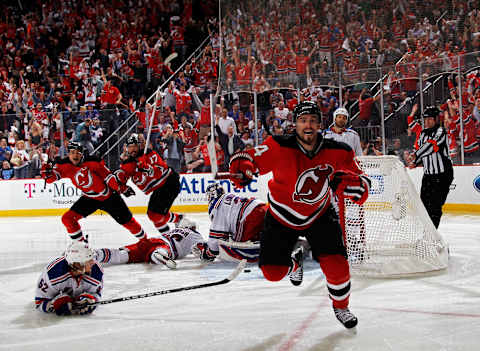
Adam Fox and I still think about that goal from time to time. It was sixty-three seconds into overtime of game six of the 2012 Eastern Conference finals when Adam Henrique scored to lift the New Jersey Devils into the Stanley Cup Finals, eliminating the top-seeded New York Rangers.
“I was at a buddy’s house. I saw a clip of that the other day; it was devastating. I don’t like that series. I don’t like to think about it as a Ranger fan”, Fox told The Hockey News.
Adam Henrique played hero in one of the all-time Devils vs. Rangers moments. 🚨 😈 🙌
— theScore (@theScore) March 25, 2020
(🎥: @NHLonNBCSports) pic.twitter.com/HAHvSJGGj3
“Henrique! It’s over!” marked the first time I was devastated as a Rangers fan. Seven-year-old me didn’t watch the goal live but was crushed upon finding out the next morning.
Now 3,980 days later, Fox and the Rangers will have an opportunity to exact revenge as they begin their quest for the cup in that same Prudential Center in New Jersey on Tuesday night.
“It’s a rivalry,” Mika Zibanejad said of the upcoming Hudson River clash, “They’re right across the river. It’s a tough opponent, and they’ve had a really good regular season. It’s been tight games against them this season. It’s going to be a lot of fun”. Throughout the regular season, the Rangers have attempted to prove they’re better than last year’s team, who reached the Eastern Conference finals. The additions of Vincent Trocheck, Patrick Kane, and Vladimir Tarasenko have fans confident this team will bring the Stanley Cup to Broadway for the first time since 1994.
However, they must first overcome their chief rivals, who have gone from picking third in the draft to finishing third in the NHL’s overall standings in less than ten months. The series beginning in the Garden State is no accident, and it goes beyond the Devils taking seven of a possible eight points from the Rangers in their regular season meetings. Here’s a deep dive into what’s made New Jersey great and how New York can be the team to stop them.
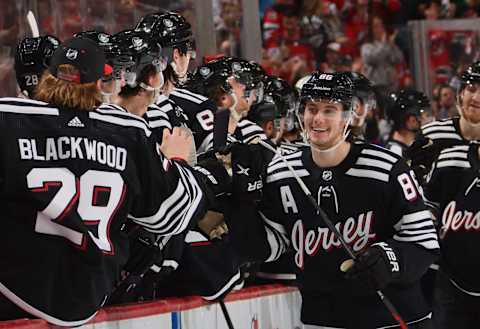
The Devils being back in the dance for the first time since 2018 marks the end of their rebuild. Despite entering the season as the league’s fifth-youngest team with an average age of 25.8, New Jersey began the season 16-3, turning heads with a 13-game winning streak and hasn’t looked back. They finished the season with 52 wins and 112 points, both franchise records.
New Jersey is led by a pair of first-overall picks in captain Nico Hischier(2017) and Jack Hughes(2019), who have emerged as franchise stars. Hughes’s 99 points(43 goals, 56 assists) broke the Devils franchise record for most in a season, while Hischier’s 31 goals and 80 points are a career-high.
Also emerging from the youth fountain were 21-year-old Dawson Mercer and 23-year-old Jesper Bratt. Bratt’s 11-game point streak to begin the season set a franchise mark, while Mercer’s eight-game goal streak from February 16-March 3 was also a Devils record. As if they couldn’t get any younger, Jack’s brother, Luke Hughes, 19, made his NHL debut last week after a standout season at Michigan. The defenseman promptly introduced himself with the overtime winner on Thursday in his second game, lifting the Devils to a 5-4 at the Washington Capitals in the season finale.
New Jersey also added veterans such as forwards Ondrej Palat and Tomas Tatar and defenseman John Marino and Dougie Hamilton, whose 71 points(20 goals and 51 assists) made him the second defender in franchise history to record at least 70 points in a single season. Then, GM Tom Fitzgerald topped it off at the trade deadline and acquired arguably the top player on the market in 40 goal-scorer Timo Meir from the San Jose Sharks.
The Hockey News published an issue last season with the cover stating,” The Devils are building a beast.” That beast has now arrived, albeit ahead of schedule, and will look to announce themselves on the playoff stage by vanquishing their Hudson River rivals—next, a look at how they plan to do that.
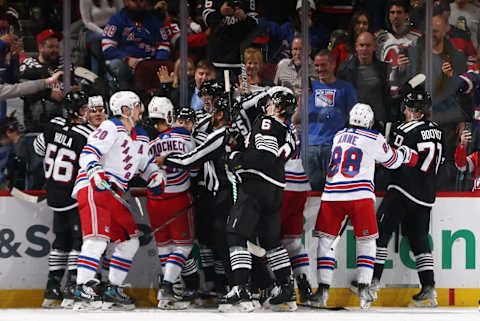
In addition to their eye-opening skill, the Devils thrive off of speed. They led the league with 43 goals off the rush and, most notably, overwhelmed the slower Rangers in their meetings.
New Jersey’s relentless attack has allowed players like Tomas Tatar and Erik Haula to thrive and create constant scoring opportunities, leading to sustained offensive zone pressure. “When they have the puck, they like to circle and build speed, so you’ve got to be tight,” Jimmy Vesey said.
Stopping speed has been a problem for the Rangers this season. They finished 22nd in defending transition opportunities, 31st with 747 in even-strength giveaways, and their negative186 turnover differential was fourth worst in the NHL, respectively, according to Natural Stat Trick, as derived by lohoud.com. When they don’t score off the rush, the Devils crash the net well, as they rank third in banging in rebounds and first in creating net-front opportunities with 989 high-danger chances. Meanwhile, New York ranked 21st in rebounds against and 24th in chances against from the slot.
The Devils are an offensive juggernaut and will quickly make you pay for your mistakes. However, these Rangers have the playing style, talent, experience, and goaltending fit for the challenge.
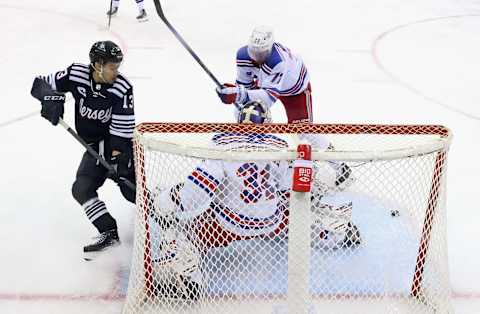
There’s no team in the Eastern Conference as skilled as the Rangers. Their star power and depth are unrivaled by anyone in the Metropolitan Division, and when all fails, reigning Vezina-winner Igor Shesterkin is back there to rescue them.
However, when you play a fast team like the Devils, there’s rarely time to settle play down, which means you must do damage on “Broken plays” and be opportunistic when you have time for clean shots.
SHOOT & CRASH:
New Jersey ranked 31st this season in defending shots off of “Broken plays” (441) yet finished ninth in total goals allowed (222).
The last respectable defensive numbers are primarily due to the play of goaltender Vitek Vanecek, who signed for three years at $3.4 million AAV last Summer before beating out Mackenzie Blackwood for the starting job. While he’s no Shesterkin, Vanecek will stop the puck if he sees it. To beat him, the Rangers must create screens and bury rebounds, an area where they ranked 27th this season, according to the Athletic.
POWER UP:
Special teams will come down to execution, as the Rangers’ power play finished seventh while the Devils’ penalty kills ranked fourth. If the Blueshirts aren’t passive and bring their shoot-first mentality to this series, they should make enough dents in New Jersey’s armor to be effective. On the flip side, New York’s penalty kill finished 13th, identical to the Devils’ man-advantage ranking.
USE YOUR MANPOWER:
As Henrik Lundqvist brilliantly said on MSG Network, “You play against great teams; you have to take away their biggest strength. For the Devils, it’s their speed, and the Rangers need to hit more and slow them down.” On paper, the Rangers are the deeper and more talented team. They boast a lethal top six in Artemi Panarin, Mika Zibanejad, Patrick Kane, Chris Kreider, Vincent Trocheck, and Vladimir Tarasenko. Moreover, they have a third line filled with experienced kids in Filip Chytil, Alexis Lafreniere, and Kaapo Kakko and a fourth line loaded with grinders in Jimmy Vesey, Tyler Motte, and Barclay Goodrow.
The required “Dump and chase” style of play is what they imposed last Spring against the Carolina Hurricanes and Tampa Bay Lightning, which is where the “Experience” factor kicks in. Suppose New York plays disciplinary hockey in the neutral zone and uses their composure and physicality to frustrate the upstart Devils. In that case, they should be in an excellent position to win this series.
SHOWTIME NEEDS TO SHOW UP:
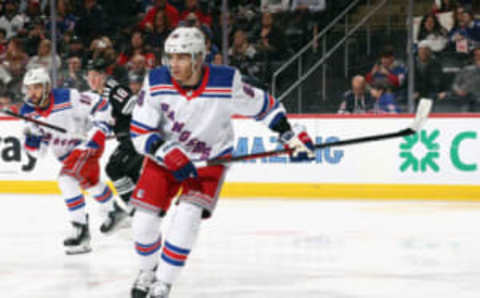
Artemi Panarin, Mika Zibanejad, and Chris Kreider will lead the Rangers offensively. Refrain from counting out trade deadline acquisition Vladimir Tarasenko, who had eight goals and 21 points in 31 games with the Blueshirts after being dealt by the Blues.
Yet if the Rangers outscore New Jersey, it will likely be because of Patrick Kane’s production. Although he has 12 points in 19 games since arriving on Broadway, Showtime hasn’t been the game-changer fans expected the superstar to be. True, Kane is no longer at the height of his powers. But he still showed he could be effective on a putrid Chicago Blackhawks team.
“The one thing you want to be known as is a playoff performer, a big game player,” the three-time Stanley Cup champion and former Conn Smythe winner said, “Here we are again.”
THE SHESTERKINATOR:
If Igor is even remotely close to the superhuman he was last season, the Blueshirts will be nearly impossible to overcome. There were times this season when Shesterkin looked shaky, but since the beginning of March, he’s gone 11-3-1 with a 1.98 GAA and .934 save percentage. Despite his previous struggles, the netminder finished the season fifth, with a +28.1 Goals Saved Above Expected. In contrast, Vanacek’s +5.1 Goals Saved Above Expected ranked 26th.
“You can see the focus between his eyes,” Rangers defenseman K’Andre Miller told NHL.com. “He brings that intensity to the rink. That’s everything. That’s what you want to see from your starting goalie.”
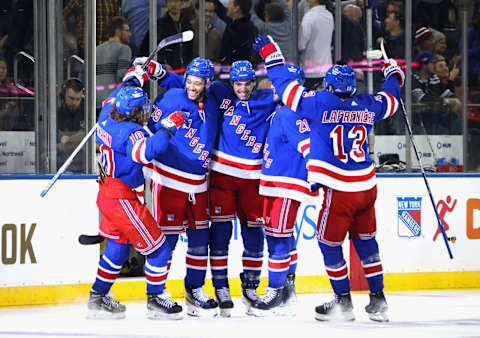
The buildup for this series sees the upstart Devils, facing a Rangers team that took that leap a season ago and enter as the favorites despite being the lower seed. Ironically, the last time both teams made the playoffs at the same time was in 2012, when they eventually squared off in the Eastern Conference Finals.
The Battle of the Hudson has even reached my family’s weekly Strat-O-Matic league. For those unaware, Strat-O-Matic hockey, is a board game comprised of player cards based on statistics from the previous season. It’s essentially fantasy hockey on a board. We decided to do an NHL-style league where you control a team, and coincidentally, the Rangers and Devils(Yes, the rosters have been updated) will be meeting up in the first round of the playoffs this week.
It’s the postseason rematch fans have waited 11 years to see again. These two rivals are evenly matched, and one could make valid arguments for either to advance. Ultimately, I see the play of Igor Shesterkin being the difference. Rangers in seven.